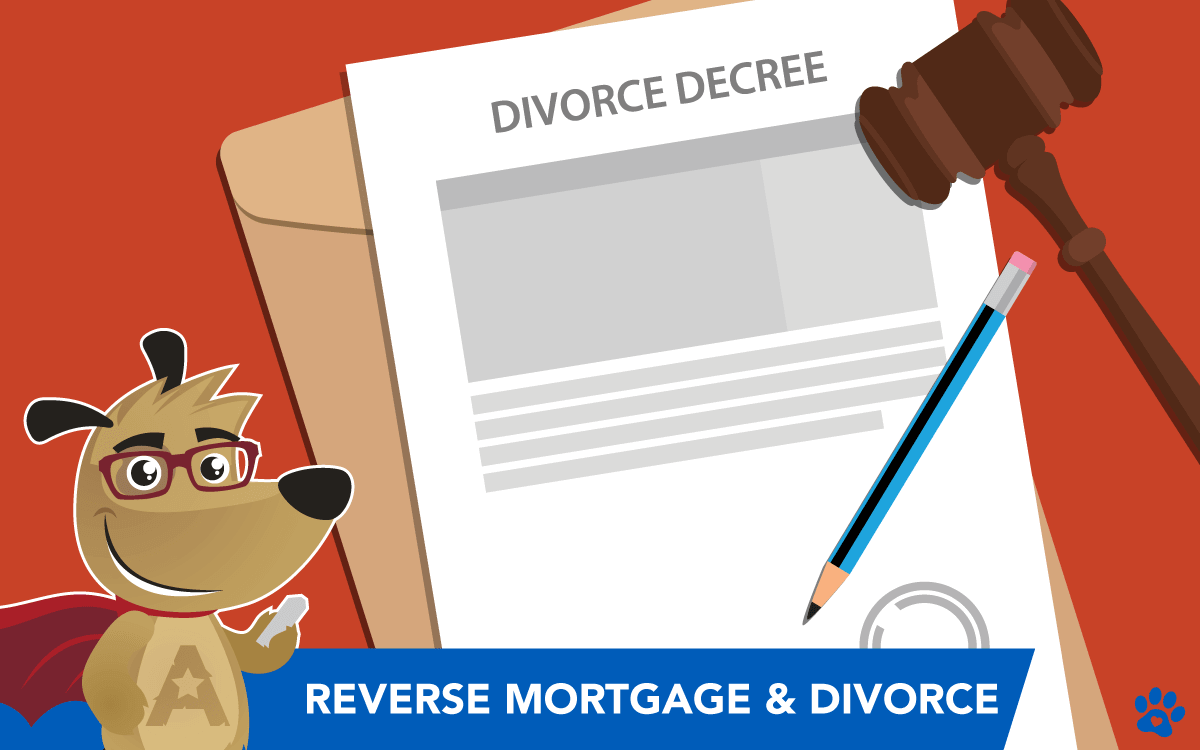How to use a Reverse Mortgage in a Divorce Settlement
 |
Michael G. Branson, CEO of All Reverse Mortgage, Inc., and moderator of ARLO™, has 45 years of experience in the mortgage banking industry. He has devoted the past 20 years to reverse mortgages exclusively. (License: NMLS# 14040) |
 |
All Reverse Mortgage's editing process includes rigorous fact-checking led by industry experts to ensure all content is accurate and current. This article has been reviewed, edited, and fact-checked by Cliff Auerswald, President and co-creator of ARLO™. (License: NMLS# 14041) |
While the concept of a reverse mortgage is often associated with bolstering financial stability for retirees, its utility extends beyond mere retirement planning. Beyond its ability to aid those meeting the 62-year-old age requirement in enhancing monthly cash flow or eliminating mortgage payments, there exists a lesser-known yet significant application: navigating divorce situations.
For couples facing the complexities of asset division, particularly when substantial home equity is involved, a reverse mortgage can serve as a vital financial tool. By tapping into home equity, it offers a lifeline during the intricate process of asset distribution, alleviating financial strains and fostering equitable living arrangements for both parties.
In this article, we dive into the often-overlooked role of reverse mortgages in divorce scenarios, exploring how they can streamline financial negotiations and provide a pathway to a more secure post-divorce future for all involved.

Maintaining Independence: Reverse Mortgages for Separate Living Arrangements
Navigating a separation later in life often brings significant financial adjustments, particularly when it comes to sustaining a household once supported by dual incomes. In such circumstances, a reverse mortgage emerges as a valuable solution, offering flexibility and financial stability during this transitional phase.
A reverse mortgage provides individuals with the freedom to access their home equity in various ways, tailored to their specific needs. Whether opting for a lump sum, periodic payments, or a combination, the reverse mortgage can empower individuals to manage their finances effectively, especially when one spouse intends to maintain residence in the home but struggles with monthly mortgage obligations.
Consider this scenario: You own a $300,000 home with an $80,000 mortgage balance at age 72. With a reverse mortgage, you can access over $200,000, using $80,000 to settle the existing mortgage while retaining $120,000 for other purposes. Notably, funds can even be disbursed to the departing spouse at the loan’s closing, facilitating a smooth transition. It’s essential to note that during the loan term, the departing spouse must be removed from the home title, a process often streamlined alongside loan initiation.
However, it’s important to recognize that like all reverse mortgages, repayment becomes due upon the borrower’s relocation or passing. Additionally, borrowers must fulfill obligations such as property tax and homeowners insurance payments throughout the loan duration. This arrangement enables one spouse to enjoy a mortgage-free existence while the other can allocate resources towards savings or other financial priorities, fostering financial independence and stability for both parties.
Exploring the Reverse Mortgage for Purchase Option During Divorce
Amidst a divorce, a ‘Reverse Mortgage for Purchase‘ can be a strategic financial tool if neither spouse wants to stay in the family home. This innovative option combines the purchase of a new home with the benefits of a reverse mortgage, all in one transaction.
This approach can be particularly advantageous for a divorcing couple. It enables one spouse to seamlessly transition to a new residence using a reverse mortgage, while the other may receive a portion of the cash proceeds. This solution is especially fitting for those considering downsizing.
Leveraging a reverse mortgage for purchase can simplify the property division process in a divorce, ensuring both parties can move forward with their new living arrangements and financial independence.
If you get divorced and already have a reverse mortgage
When a couple with a reverse mortgage together decides to get a divorce, they must submit the divorce decree to the loan servicer. At that point, one of the spouses will be permitted to be removed from the home title, keeping the loan in the remaining spouse’s name.
Managing a Reverse Mortgage During a Divorce
For couples who are undergoing a divorce and already have a reverse mortgage, it’s important to understand the necessary steps to manage this financial arrangement. Upon deciding to divorce, the couple must provide their divorce decree to their loan servicer. This is a key step.
Following this, the process allows for one spouse to be officially removed from the home’s title. Consequently, the reverse mortgage loan will then be solely in the name of the remaining spouse. This procedure ensures that the reverse mortgage terms are appropriately adjusted to reflect the new ownership status, providing a clear path forward for both parties in managing their joint financial commitments post-divorce.
Options for Dividing Home Equity in Divorce: Selling, Refinancing or Reverse Mortgage
| Option | Description | Pros | Cons | Key Considerations |
|---|---|---|---|---|
| Selling the Property | Selling the home and dividing the proceeds. | Clear and immediate division of assets; liquidation of equity. | Both parties must relocate; dependent on market conditions. | Timing, market conditions, and potential capital gains taxes. |
| Refinancing | Obtaining a new mortgage to pay out the spouse’s share. | Retain ownership of the home | Qualification for a new mortgage required; potential closing costs and higher mortgage payments. | Credit score, income stability, and ability to manage increased mortgage debt. |
| Reverse Mortgage | Taking out a reverse mortgage to pay the spouse’s share of asset. | No monthly payments required; allows one spouse to remain in the home. | Depending on the occupying spouse age, may not qualify for full 50% loan-to-value to split asset evenly. | Age requirements (usually 62+); suitability for the remaining spouse's long-term financial plan. |
Top FAQs
What happens to a reverse mortgage in a divorce?
Can a reverse mortgage be taken to fund/settle the divorce payout?
How does my existing reverse mortgage affect my new spouse?
Will a divorce cause my reverse mortgage loan to be called due and payable?
If I divorce, can I get a new reverse mortgage of my own?
If you are co-borrowers and separate, and one buys a new house, does the reverse mortgage become due if the other stays in the reverse house?
ARLO recommends these helpful resources:




 Michael G. Branson
Michael G. Branson Cliff Auerswald
Cliff Auerswald

December 7th, 2025
December 7th, 2025
December 6th, 2025
December 6th, 2025
April 30th, 2024
April 30th, 2024
December 8th, 2023
December 8th, 2023
July 19th, 2023
July 25th, 2023
February 14th, 2023
February 14th, 2023
December 31st, 2022
December 31st, 2022
October 12th, 2022
October 12th, 2022
March 22nd, 2022
March 22nd, 2022
March 2nd, 2022
March 2nd, 2022
March 2nd, 2022
March 2nd, 2022
December 19th, 2021
December 19th, 2021
July 21st, 2021
June 29th, 2021
June 29th, 2021
April 27th, 2021
April 27th, 2021
March 4th, 2021
March 4th, 2021
February 20th, 2021
February 20th, 2021
February 11th, 2021
February 15th, 2021
November 4th, 2020
November 4th, 2020
September 27th, 2020
September 27th, 2020
September 14th, 2020
September 14th, 2020
September 1st, 2020
September 1st, 2020
August 1st, 2020
August 1st, 2020
July 8th, 2020
July 12th, 2020
July 7th, 2020
July 7th, 2020
June 29th, 2020
June 29th, 2020
June 12th, 2020
June 13th, 2020
May 3rd, 2020
May 3rd, 2020
March 16th, 2020
March 16th, 2020
November 25th, 2019
November 25th, 2019
November 20th, 2019
November 20th, 2019
November 4th, 2019
November 4th, 2019
October 6th, 2019
October 6th, 2019
August 8th, 2019
August 8th, 2019
September 9th, 2019
September 10th, 2019
July 21st, 2019
July 21st, 2019
July 20th, 2019
July 21st, 2019
July 15th, 2019
July 15th, 2019
June 17th, 2019
June 17th, 2019
June 10th, 2019
June 10th, 2019
June 5th, 2019
June 5th, 2019
May 29th, 2019
May 29th, 2019
May 20th, 2019
May 20th, 2019
May 13th, 2019
May 13th, 2019
May 13th, 2019
May 13th, 2019
May 6th, 2019
May 6th, 2019
April 23rd, 2019
April 23rd, 2019
November 13th, 2018
November 13th, 2018
October 22nd, 2018
October 22nd, 2018
October 22nd, 2018
October 22nd, 2018
October 1st, 2018
October 1st, 2018
January 25th, 2018
January 25th, 2018
January 21st, 2018
January 21st, 2018
October 19th, 2017
October 19th, 2017
June 28th, 2017
June 28th, 2017
June 3rd, 2017
June 5th, 2017
December 11th, 2016
December 12th, 2016
September 5th, 2016
September 6th, 2016
May 17th, 2013
May 29th, 2013
May 10th, 2013
November 8th, 2012